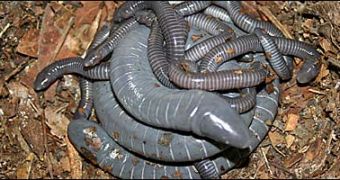First of all, only the existence of the caecilian species is odd by itself. When we think of amphibians, our mind goes to frogs and toads; some may also think of newts and salamanders. But who would suspect the tropical caecilians, resembling a combination between a snake and an earthworm, to be amphibians, sprouted from the same ancestors of the frogs and newts?
Besides being weird, the caecilians mostly live hidden in the ground, that's why they are less known than other amphibians. And if you thought frogs and toads had odd methods of taking care of their babies, the scientists were amazed to find one of the extreme and weirdest cases of maternal care in the animal world: the females of caecilians grow a ticker and nutrient-rich skin when giving birth, in order to feed their babies.
The young caecilians eat both a secretion of mother's skin and peel off strips of her skin and eat them. A recent BBC documentary presented by Sir David Attenborough has managed, for the first time, to capture such an event; a difficult task, as the caecilian offspring eat their mother's skin only for about 10 minutes, once every three days, and mainly at night. The mother is apparently unharmed by this and the babies are regularly fed this way. The young caecilians have special teeth for tearing and removing the mother's skin.
The shot was made on Boulengerula taitanus, living in the Taita Hills (south-eastern Kenya), a subterranean species that can grow up to 30 cm (1 foot) long.
"Reptiles and amphibians are sometimes thought of as slow, dim-witted and primitive. In fact, they can be lethally fast, spectacularly beautiful, surprisingly affectionate and extremely sophisticated," said Atenborough.
The filming was possible only due to the advances in camera technology, like ultra-high-speed, thermal, miniature and on-board cameras. The crew made a set resembling the shallow, humid underground chambers that the Boulengerula live in. "Caecilians breed in shallow, humid chambers beneath the soil and are light and humidity-sensitive creatures that can be easily disturbed. The team had alternate three- hour shifts watching and sleeping . . . on the benches in the scientists' lab," said a BBC spokesman.

 14 DAY TRIAL //
14 DAY TRIAL //